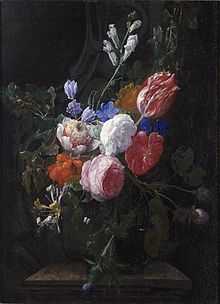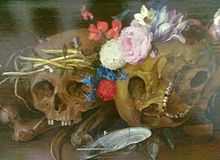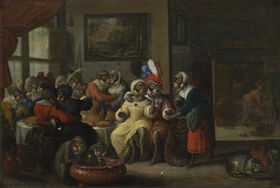Nicolaes van Verendael

Nicolaes van Verendael (alternative spellings: Nicolaas van Veerendael, Nicolaes van Veerendael, Nicolaas van Verendael) (Antwerp, 1640 – Antwerp, 1691) was a Flemish painter of flower still lifes and singeries.
Life
He trained with his father Willem van Veerendael.[1] He became a member of the Antwerp Guild of Saint Luke in 1657. Financial rewards were lean as he was a slow worker and as a result he lived modestly.[2]
He married Catharina van Beveren, the daughter of the prominent Antwerp sculptor Mattheus van Beveren.[3]
He was the teacher of priest Cano and Jean Baptiste Morel.[2]
Work
His dated works are from the period between 1659 and 1690. He mainly painted flower still lives and a few allegorical scenes with monkeys. He was highly regarded in his younger years when he worked with some of the leading Antwerp painters such as David Teniers the Younger, Erasmus Quellinus II, Carstian Luyckx and Jan Davidsz. de Heem.[2]

His early work shows the influence of the leading Antwerp flower still life painter Daniel Seghers and later he was influenced by Jan Davidsz. de Heem, Some of his still lifes include vanitas motifs and insects. Van Veerendael developed towards a brisker brushstroke in his later years and he found a personal style that was a forerunner of Flemish flower painting in the 18th century.[1]
Nicolaes van Verendael contributed to the spread of the genre of the 'monkey scene', also called 'singerie' (a word, which in French means a 'comical grimace, behaviour or trick').[4] Comical scenes with monkeys appearing in human attire and a human environment are a pictorial genre that was initiated in Flemish painting in the 16th century and was subsequently further developed in the 17th century. The Flemish engraver Pieter van der Borcht introduced the singerie as an independent theme around 1575 in a series of prints, which are strongly embedded in the artistic tradition of Pieter Bruegel the Elder. These prints were widely disseminated and the theme was then picked up by other Flemish artists in particular by those in Antwerp such as Frans Francken the Younger, Jan Brueghel the Elder and the Younger, Sebastiaen Vrancx and Jan van Kessel the Elder. David Teniers the Younger became the principal practitioner of the genre and developed it further with his younger brother Abraham Teniers. Later in the 17th century Nicolaes van Verendael started to paint these ‘monkey scenes’ as well.[5]
References

- ↑ 1.0 1.1 Els Vermandere. "Veerendael, Nicolaes van." Grove Art Online. Oxford Art Online. Oxford University Press. Web. 5 Mar. 2014
- ↑ 2.0 2.1 2.2 Nicolaes van Verendael at the Netherlands Institute for Art History (Dutch)
- ↑ Mattheus van Beveren at the Netherlands Institute for Art History (Dutch)
- ↑ 'Singerie' in Larousse online (French)
- ↑ Bert Schepers, Monkey Madness in Seventeenth-Century Antwerp, in: The Rubenianum Quarterly, 2012 2, p. 5
Further Reading
- Liedtke , Walter A. (1984). Flemish paintings in the Metropolitan Museum of Art. New York: The Metropolitan Museum of Art. ISBN 0870993569. (p.270-272, v.1; plate 105, v.2).
External links
| Wikimedia Commons has media related to Nicolaes van Verendael. |
|